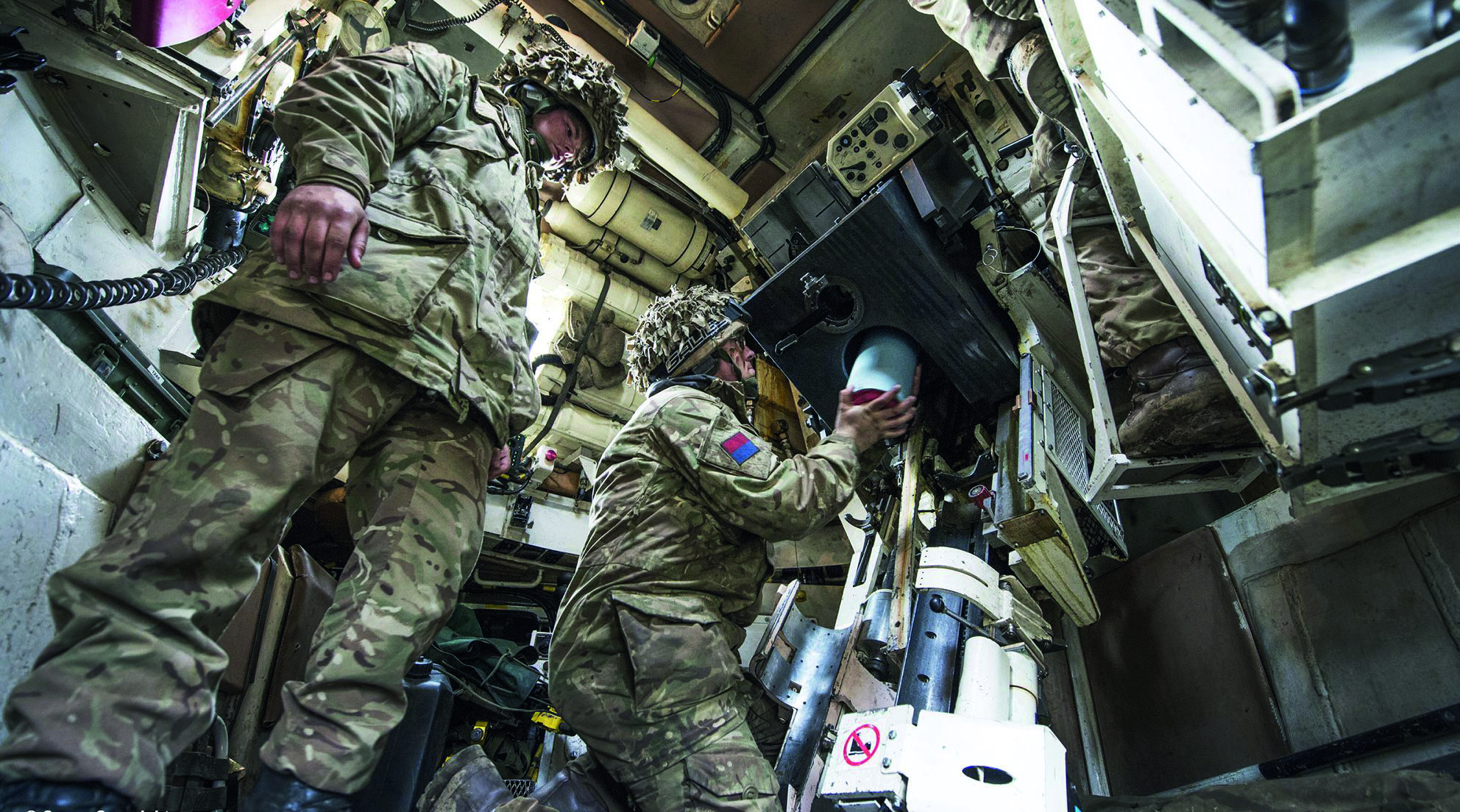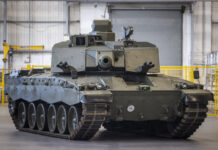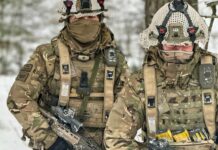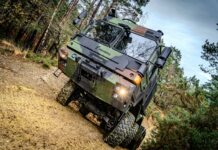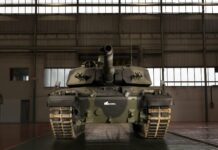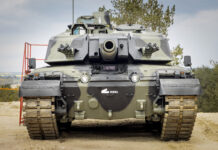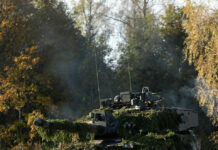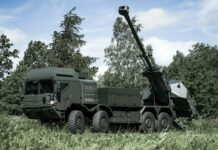According to the latest ‘UK Armed Forces Equipment and Formations’ tabular data published by the Ministry of Defence (MoD) on 9 September 2021, the British Army currently operates a total of 89 AS90 155 mm/L39 self-propelled guns. Unfortunately, the reality is somewhat different. There might be 89 AS90 on paper, but the actual number of operable AS90 systems is significantly less. Depending on who you talk to and how frustrated they are, real operational AS90 probably number at less than 20 and possibly even closer to 10 or fewer systems that can actually take the field!
The ‘Artillery System for the 1990s,’ otherwise known as the AS90 had the misfortune to come into service as the Cold War had just ended. The British Army of the Rhine (BAOR) and the continental commitment that had been the primary mission of the British Army in the post-1945 period was coming to an end. Uncertainty surrounded the size and structure of the post-Cold War British Army, on top of which there was the reduction in defence spending across the course of the 1990s, with the exception of 1991 where spending was briefly boosted due to the Gulf War.
By the end of the 1990s there was a plan to upgrade the AS90, but this project failed to yield satisfactory results and was cancelled. Year on year, the AS90 fleet started to decline in terms of numbers and capability, a situation not helped by the fact that spare parts availability became increasingly uncertain. If a self-propelled 155 mm artillery system had been seen as a critical capability then things might have been different, but as time went on systems that were essential for high intensity conventional conflicts, such as the AS90 and tanks, were seen as diminishing in relevance, and numbers were significantly reduced.
With the British Army embroiled in asymmetric conflicts and with conventional threats seemingly less and less likely, where was the need for systems such as the AS90? With a limited budget, the British Army had to use its resources in areas that mattered and self-propelled artillery did not. Then in early 2014, Russia seized Crimea from Ukraine and in August of that year, conflict opened up in the Donbas, with Russian troops actively supporting separatists in Donetsk and Luhansk. Suddenly the threat of conventional conflict in Europe started to emerge as a real possibility and gradually the UK’s thoughts turned to what would be required to confront conventional threats.
While there might have been thinking about conventional threats, there was little in the way of new funding to meaningfully confront such threats. Indeed, the British Army, like many others in Europe, found itself expected to do more with less and in that environment a great deal of effort was put into trying to define a new structure for the Field Army that would allow it to confront increasing conventional, as well as other threats, within the existing limits of its funding.
Gradually programmes that focussed on weapons for conventional high intensity conflict began to appear, though sadly the funding constraints that had hampered the British Army had not disappeared. The end result was that many programmes would emerge, of these very few would survive to enter the procurement phase, and even then cancellation always remained a threat, the fate of the WARRIOR Capability Sustainment Programme (WCSP), awarded in 2011 and cancelled in March 2021, being a case in point.
The Artillery Problem
In the midst of all of this, an artillery programme started to emerge and eventually this became known as the Mobile Fires Platform (MFP). The fundamental objective of this programme is to replace the AS90 with a modern self-propelled artillery system. According to the ‘Defence in a Competitive Age’ defence command paper issued in March 2021: “Investment in longer range artillery will mean the Army is able to deliver a more precise and lethal response and attack potential adversaries at greater depth, providing greater protection.” The paper continued: “In addition the Army is spending over £800 million over the next ten years on a new automated Mobile Fires Platform that will deliver enhanced close support artillery systems and greater operational mobility.”
The fact that a funding allocation is mentioned in an official document is very good news for those intending to compete for the programme, another positive sign is that the ceiling for the number of MFP systems to be acquired is up to 116. Where things get complicated is that at this point there is no official operational requirement for MFP, it is still being drafted, but the competitive process for the MFP programme should get underway by January 2023. This means that a lot of steps in the procurement process will have to be fitted into a relatively short timescale, especially since the MFP contract award is expected to be in 2026.
In the early stages of trying to define performance parameters for MFP, there were some very ambitious requirements being spoken about, these included a maximum range of some 80 km and an extremely high rate of fire. In fact, the British Army Land Deep Fires capability is due to be provided by 44 MLRS launchers that will be upgraded to the M270B1 standard and utilise the Guided Multiple Launch Rocket System – Extended Range (GMLRS-ER) rocket, which will boost engagement ranges from 84 km out to 150 km. This means the starting point for MFP will be 155 mm/L52 Joint Ballistics Memorandum of Understanding (JBMOU) compliant ordnance, meaning that there is a 40 km baseline maximum range requirement.
A new range of artillery ammunition is to be acquired for MFP under the Close Support Fires Programme (CSFP), natures to be acquired are likely to include: a guided munition, a Rocket Assisted Projectile (RAP), a High Explosive, Base-Bleed (HE-BB) nature and an anti-armour area munition using sensor-fuzed submunitions. Another separate but related MFP contract will cover the provision of a training system for the programme.
Timings for MFP are interesting, the out of service date for the AS90 was to be 2030, although it now appears to be 2032, which is rather strange considering that there are hardly any functional AS90s these days. So how do they intend to sustain a capability that has virtually wasted away for another ten years?
If we assume that the MFP enters service in around 2029, it is expected to remain in service through the 2050s. The variant of MFP that first enters service will reflect the current level of technology of self-propelled artillery systems. However, remaining viable across its envisaged service life will require the MFP to have substantial growth potential, to be capable of ‘forward capability insertion.’ This could include new ordnance capable of increased range engagements, new ammunition, an improved autoloader, automotive improvements such as a hybrid engine and perhaps even autonomous operation. Bearing in the mind that the service life of the MFP will be at least 30 years, and most likely longer, the ability of the of the artillery system to evolve across its service life will be a critical discriminator in the selection of the MFP.
Lessons and Requirements
In asymmetric conflicts post-2000, British Army artillery generally found itself operating from static positions. It will now have to learn the lessons necessary for mobile operations on a modern battlefield, where artillery systems will be a key target for opposing forces. The starting point is the recognition that because the British Army has been so resource-constrained over the last 25 years, it desperately needs to modernise its land-based fires. This modernisation process is finally underway, as previously noted 44 M270B1 systems will fill the long-range fires requirement, followed by MFP to replace AS90, and finally there will be a replacement for the L118 105 mm Light Gun. There were 126 of these in service, but 36 have recently been transferred to the Ukraine.
Although the requirement for artillery modernisation has been accepted, how it can best be achieved remains a fluid concept. Discussions of future artillery utilisation have been underway for some time, but now the role of artillery in the current conflict in Ukraine has provided a stream of new data to analyse and evaluate. First and foremost, the conflict in Ukraine has confirmed the essential role of artillery on the modern battlefield. However, it has also demonstrated that the UK’s older concepts of artillery employment are no longer feasible, the artillery will have to learn to fight their guns differently on future battlefields.
Mobility, both tactical and operational, is an essential characteristic for the future MFP. Static gun lines are a thing of the past, artillery must move about the battlefield, and dispersal is essential for survival. MFP must be capable of rapidly entering its fire position, conducting its fire mission, and then repositioning rapidly. An autoloader system is also crucial to keeping its time at the fire position as low as possible. Connectivity is equally important, guns will need to be linked to a command and control (C2) network, with targeting data acquired from multiple Intelligence, Surveillance, Target Acquisition, and Reconnaissance (ISTAR) sources and then transferred from command levels to the gun systems to allow multiple dispersed gun systems to engage single or multiple targets.
While mobility aids survivability, there are other aspects that can add to the survivability picture. The platform itself needs a respectable level of armour protection and its own close-in protection, such as a Remote Weapon Station (RWS) mounting a 7.62×51 mm or 12.7×99 mm machine gun. Another useful capability would be an effective Counter-UAV capability, since armed UAVs will be a major threat to artillery. A further addition could be equipping the MFP with an Active Protection System (APS), high value systems such as tanks and now IFVs are being given APS installations, given the importance of artillery systems should they not receive the same protection priority?
Another important issue for the MFP system is crew size, especially given most European armies are having to cope with limited personnel numbers. In the context of MFP, the ideal crew size is three, which can be achieved with an autoloader and other technologies to reduce crew workload. In future the level of automation in MFP will inevitably increase, with the possibility that MFP eventually evolves into a completely autonomous unmanned system, though such a capability will be many years into the future.
To summarise then, the MFP will be a revolution in self-propelled artillery for the British Army, with the revolution continuing through the service life of the system thanks to the insertion of new technology. In conjunction with GMLRS-ER, MFP will finally give the British Army a land-based fires capability that can truly support its operations on the modern battlefield. Until that situation is reached, the British Army will remain dependent on allied nations for the majority of its land-based fires.
Industrial Aspects
It is expected that the MFP operational requirement will be written in such a way that it can accommodate both tracked and wheeled solutions, which will open up MFP to the broadest spectrum of candidate systems. One contender that has already built up a fair degree of momentum as regards MFP is KMW, with their RCH 155 (Remote Controlled Howitzer 155 mm) 155 mm/L52 gun system in a module that can be integrated with the BOXER armoured vehicle. With BOXER seen as one of the few procurement relative success stories in Britain in recent years, a further BOXER-related capability is seen, at the political level at least, as a very good thing.
Then there are the other wheeled solutions to consider, these will doubtless include BAE Systems with the ARCHER, Nexter with CAESAR and Elbit with their ATMOS or ATHOS solutions. Rheinmetall is also seen as a potential contender for MFP, although they are also seen as a strong candidate for the supply of future 155 mm ammunition to support the MFP. Other ammunition suppliers that are seen as credible candidates include BAE Systems and Nexter.
Then there is a major challenger for the MFP programme in the shape of Team Thunder, their proposal is centred on the Hanwha Defense K9A2 system. Other members of Team Thunder include Lockheed Martin UK, Pearson Engineering, Leonardo, Soucy Defense and Horstman. The case for the K9 and Team Thunder was strengthened in July when Hanwha signed a framework contract for 672 K9 systems! Other countries with the K9 in service or on order include: Australia, Egypt, Estonia, Finland, India, Norway, the Republic of Korea (ROK) and Turkey. The fact that the system is in service with NATO partners aids with interoperability and supportability, plus joining the K9 user group will reduce the cost of future K9 spiral development.
Where Team Thunder could have an edge in MFP is that Hanwha Defense have a very credible record in the transfer of technology, establishing local production with their partners and integrating local content in K9 systems. A strong economic acquisition case is one thing, where K9 could also have an advantage is there is a development roadmap in place for the system that adds improved operational capabilities through the 2040s and beyond, for example the integration of a 155 mm/L58 gun. Selecting the K9 for MFP would allow the British Army and British industry to participate in these future K9 developments.
Hanwha Defense also intends to base a ‘Centre of Excellence’ in the UK for the maintenance and upgrade of European K9 systems, creating further business opportunities for British industrial partners. Beyond that, should the British Army require early MFP delivery, Hanwha Defense could potentially support that because the ROK Army will achieve Initial Operating Capability with the K9A2 in 2027.
In the end, winning MFP will come down to who has the best offer to meet the operational requirement, and who can present the most convincing case on the evolutionary possibilities of their system over the MFP’s service life. The other critical selection criteria will be who presents the most compelling industrial and economic offer. Undoubtedly, MFP is a fascinating programme and as far as the British Army is concerned it is also an essential programme.


